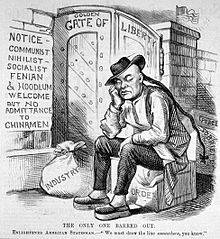1. The article written by Min Hyoung Song called “How Good It Is to Be a Monkey” discusses about the comics called American Born Chinese created by Gene Luen Yang. The article is an extensive discussion about American Born Chinese comics and all the racial tensions between Asian and Asian Americans, along with the ultimate tension between Asian immigrants and themselves. The article talks about how the comics was able to show what it is like for a young Asian immigrant teenager to grow up in America. In order to do so, the comics has to throw away its light-hearted nature and take on more serious controversial topic such as race. The comics proves that it is difficult but not possible to portray by using the racial formation theory to effectively show that race can no longer be base upon a person’s look.
2. One example of how the comic portray how racism happens everyday in media by creating a character whose name is “Chin-Kee”. His name is a “grotesque stereotype of the Chinese as racially alien” (78). A person looks has nothing to do with who they are as an individual. The name “Chin-Kee” is exactly why the author suggest that there needs to be a discussion about racial formation. Without it, people will constantly label Asian American as this foreign subject who will never blend in with the society with their distinct look. Another example of how Asian immigrants are portrayed as “foreign” is how the comic mentions the story of “Monkey King”. Monkey King is a popular Chinese character that appears in Chinese movies for many years. The society that the Monkey King lives in see him as a foreign subject for his monkey-like appearance.
3. One key term that I already briefly mention is “racial formation”. This term was coined by Omi and Winant whose use the racial formation to talk about races and not only solely use appearance to talk about a certain group of people. Using racial formation, we can talk about race by examining how race causes certain conflict between that race and other races and conflict within that race itself. For example, the comics bring up a lot of tension between Asian immigrants and Asian American. These two groups share many differences and similarities at the same time. Another term that mentions a lot in the article is “comics”. Its meaning it self-explanatory but in terms of the article, comics carry a lot of meanings when it tries to bring up controversial topic. Graphic artists have to be especially brave in order to talk about races in their work. Comics often take on race too mildly and therefore, it is hard to talk about race in a serious matter when comics are mainly for young audience who might not clearly understand the term “race” and how it has been a high debated topic throughout the history.
4. This comics reminds me a lot about political cartoons, especially those that portray Asian American in either negative or positive light. Gene Luen Yang, the cartoonist forces us to physically see how racist stereotypes play out through the eyes of young characters. Just like other polical cartoon that portrays how Chinese immigrant were being treated in the the 1800s, Gene Luen Yang draws what is like to be a young Asian immigrant growing up in a American society. Politcal cartoons raises conversation and talks about controversial topics that ordinary people find it hard to talk about in everyday conversation.



One response to “Week 5 “How Good It Is To Be a Monkey” by Min Hyoung Song”